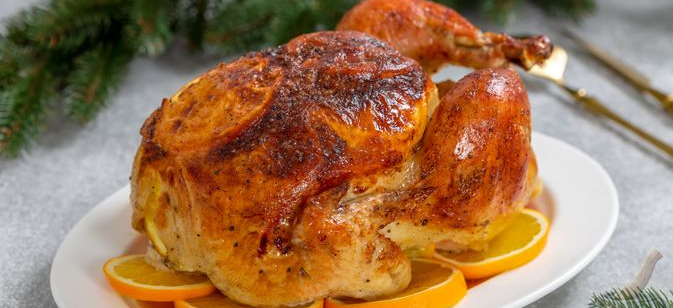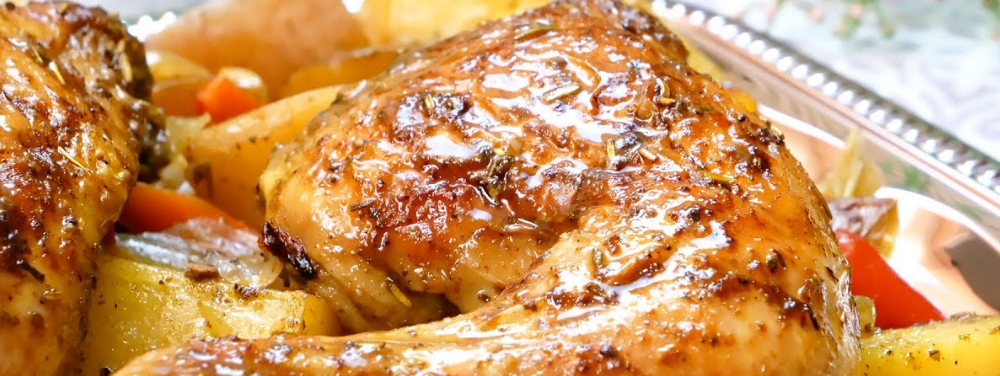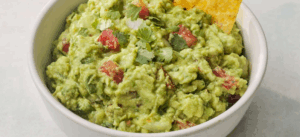How to Cook a Whole Chicken for the Holidays: A Chef’s Guide to the Perfect Festive Centerpiece
Why Chicken Is the Smartest Holiday Main
Let me put it this way: chicken is the one protein that pleases just about everyone. It’s not as heavy (or pricey) as beef, not as gamey as lamb, and a whole lot easier to manage than turkey. When cooked right, a whole roasted chicken looks elegant, tastes fantastic, and makes your house smell like home.
That’s why, when I’m planning a holiday meal — whether it’s Christmas, Thanksgiving, Easter, or just a big Sunday dinner — chicken is my go-to when I want to keep things warm, beautiful, and low stress.
Choosing the Right Bird
You want a chicken that’s about 4 to 5 pounds. Anything smaller can dry out too fast. Bigger than 6 pounds and you risk uneven cooking.
Go for fresh, never frozen if you can. Air-chilled chickens roast up with crispier skin. Organic is great if your budget allows, but not a must. What matters most is that it’s plump, well-shaped, and not pumped with saline.
What You’ll Need (My No-Fail Base Recipe)
A whole chicken
Olive oil or softened butter
Kosher salt
Black pepper
A lemon
A whole head of garlic
Some fresh thyme or rosemary
Optional: smoked paprika for color
Some root vegetables like carrot, onion, and celery to roast under the chicken
And if you want extra aroma, toss in an apple wedge or a few bay leaves inside the cavity. You don’t eat the stuffing — it’s just there to perfume the bird.

My Step-by-Step Process
First, take the chicken out of the fridge about 30 minutes before roasting. This helps it cook evenly. Pat it dry — really dry. Moisture is what stops skin from crisping.
Rub the chicken all over with olive oil or butter, then season it inside and out with salt, pepper, and optional paprika.
Stuff the cavity with halved lemon, garlic, and herbs. You don’t need fancy stuffing — the steam from the aromatics does the work.
Truss the legs together with kitchen twine and tuck the wings under so the tips don’t burn.
Lay the bird breast-side up on top of rough-cut carrots, onion, and celery in a roasting pan. This bed of veggies keeps it elevated and flavors the juices.
Roast in a 425°F oven for 20 minutes. Then drop the temp to 375°F and keep roasting another 45 to 60 minutes, depending on bird size.
How to know it’s done? The juices should run clear when you pierce the thigh, and a meat thermometer in the thickest part of the leg should hit 165°F.
Now stop. Don’t cut it right away. Let it rest 15–20 minutes. That’s when the juices settle back into the meat. If you skip this, even a perfect bird can turn dry.
How to Serve It Beautifully
Put the whole chicken on a wooden board or white platter. Add sprigs of rosemary, some roasted garlic cloves, maybe a little pile of lemon wedges. Slice at the table if you’re feeling bold. It turns dinner into a little ceremony — and people love it.
Nutrition Info (Per Serving, Roughly 6 oz Cooked Portion)
| Part | Calories | Protein | Fat | Notes |
|---|---|---|---|---|
| Chicken breast | 165 | 31g | 3.5g | Leanest, most popular cut |
| Chicken thigh | 205 | 25g | 10g | Juicier, more flavorful |
| Skin (optional) | +40–60 | – | 4g | Adds crisp + flavor |
| Olive oil (rub) | +40 | – | 4.5g | Helps browning + flavor |
| With stuffing | +50–150 | – | Varies | Depends on what you add |
Bottom line: a full plate with breast meat, a bit of skin, some pan veggies and gravy will run you around 350–500 calories — and you’ll feel completely satisfied.
Chef’s Personal Tips
If you want deeper flavor, rub herb butter under the skin before roasting — it melts through the meat.
Want a glossy, sweet finish? In the last 15 minutes, brush with a mix of maple syrup and a touch of Dijon mustard.
Roasting more than one chicken? Stagger them in the oven and rotate pans halfway through for even browning.
Making gravy? Strain the pan juices, whisk with a bit of flour and butter over low heat until silky. No cube bouillon. Just the real stuff.
Why This Dish Works Every Time
No matter your cooking skill, this chicken has your back. You can dress it up or keep it rustic. You can prep most of it ahead. And you’ll get that warm, happy silence around the table when people take their first bite.
It’s not just chicken. It’s home on a plate.
FAQ: Real Problems When Cooking Chicken — Answered by a Chef
Why is my chicken always dry?
You’re either overcooking it or not letting it rest. Use a meat thermometer — 165°F at the thickest part is perfect. Pull it out right then, cover with foil, and let it rest 15 minutes. That’s when the juices settle back in.
My skin never gets crispy. What am I doing wrong?
Moisture is the enemy of crisp. Always pat the chicken dry before seasoning. Don’t cover it while roasting. Rub with oil or butter — never water-based marinades. And give it that initial high-heat blast (425°F for 20 minutes) to crisp the skin early.
The breast cooks faster than the legs. How do I fix that?
Classic problem. Solution? Truss the bird (tie the legs together) and roast breast-side down for the first 20 minutes, then flip. Or, if you’re feeling pro: cover the breast loosely with foil halfway through.
Why does my roasted chicken taste bland?
Season inside and out. Salt the cavity, and rub oil + spices all over — even under the skin if possible. Want flavor? Go heavy on aromatics: garlic, lemon, onion, herbs. Don’t be shy with seasoning — chicken needs help.
I never know when it’s actually done. Any tips?
Get a digital meat thermometer. That’s the truth serum. 165°F in the thigh, not touching bone. Juices should run clear. If you go by time alone, you’re gambling.
My chicken is always pale. Why doesn’t it brown?
You’re either roasting too low or there’s too much moisture. Start at 425°F, rub with oil or butter, and don’t crowd the pan — steam = soft skin. Dry bird = brown bird.
Is stuffing the cavity safe?
If you plan to eat the stuffing, it has to reach 165°F inside, which can overcook the chicken. My advice: stuff for flavor only (lemon, garlic, herbs), and cook edible stuffing on the side. Same flavor, zero risk.
Can I roast it ahead and reheat later?
Yes, but reheat gently. Let it cool, store covered. Reheat at 300°F, covered with foil + splash of broth. Crisp the skin under broiler last 5 minutes. Won’t be the same as fresh, but still delicious if done right.
Why does my chicken come out uneven — dry in one part, raw in another?
Either it’s not trussed or the oven has hot spots. Try rotating the pan halfway through. Use a roasting rack or bed of veggies to raise the bird evenly. And again — let the bird come to room temp before roasting.
My pan juices burn. What can I do?
Add a splash of water or broth to the pan before roasting. Also, layer chopped carrots, celery, and onion under the bird — they lift it off the bottom and catch drippings. At the end, you’ve got the base for gravy instead of a scorched mess.





Post Comment